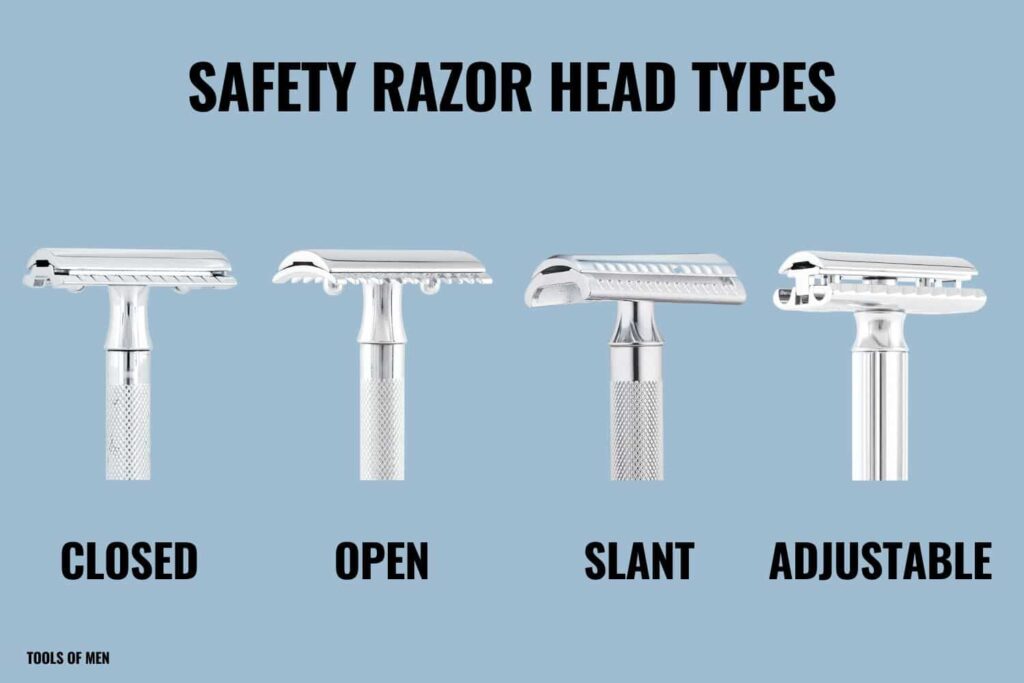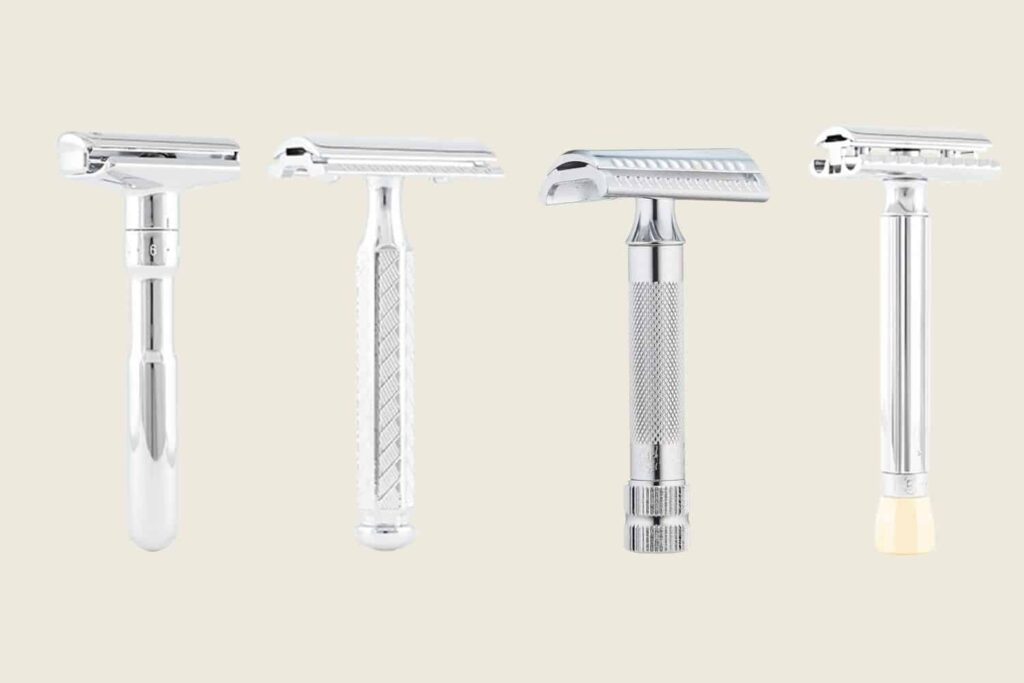Invented by King Camp Gillette in 1903, the safety razor is a shaving device designed to reduce the risk of cuts and nicks to the skin. The safety razor gets its name due to the safety bar that extends the length of the blade on either side of the head.
While there are many different types of safety razors on the market today, they all operate on the same basic principle.
In this article, we’ll talk about the design details that set various safety razors apart from one another.
Open comb vs. closed comb

One of the most distinguishing features that sets safety razors apart from one another is their comb. The comb is a piece of metal that extends the length of the blade on either side of the head. This may be a solid piece of metal, as found in closed comb safety razors, or have a rake-like design, as found in open comb safety razors. Here’s how each of them impacts the shave:
- Closed comb: Extending the width of the blade, the closed-comb design presses down evenly on the skin to prevent accidental cuts. The bar may be solid or have a scalloped design. The scalloped design is preferred by many as it glides the hair into the blade for better performance.
- Open comb: Rather than having a bar extending the entire width, an open comb razor has a rake-like design. This lessens the pressure on the skin and brings it closer to the blade resulting in a more aggressive and closer shave. Men with thicker beards find this design advantageous as it is less likely to clog.
Undecided on which you should choose?
If you are a beginner, consider the close clomb safety razor. You will be less likely to cut yourself while learning to use this shaving tool. Once you have mastered the technique, open comb safety razors offer a lot of benefits in terms of smoothness and efficiency.
Modifications to the closed comb design
While most safety razors have a standard closed comb design, some companies have modified the razor head to provide a different shaving experience. Specifically, you may find these two modifications:
- Slant: Rather than having the safety bar extend straight across, the slant bar is slightly bent. This angled design cuts hair like a French guillotine or scythe. Resulting in a close shave with reduced irritation as the blade won’t tug on the hair as it cuts.
- Adjustable: This razor relies on a knob at the bottom of the razor head that can be turned to increase or decrease the blade gap, allowing you to make the razor more or less aggressive.
Types of blades
Most safety razors rely on a double razor blade. This type of razor blade has been the standard since the original patent by Gillette in 1903. The reason for this design was to extend the life of the blade before it needed to be changed. Double-edge blades are currently made by a number of companies, including Gillette, Feather, and Astra.
Two other razor blades are also available: single edge and injector blades.
- Single edge: Found in only a few hybrid razors, notably those made by OneBlade have a single cutting edge. The most popular single edge blade is the Feather FHS-10 which has a rather rigid design.
- Injector: Found in only a few razors, notably those made by Parker Adjustable Injector Razor and Supply SE, the injector blade is a single edge blade that is inserted into the razor head using a key-like mechanism. The blade is then locked into place and can be removed by turning the key. Schick is a popular manufacturer of injector blades.
Do all safety razor blades fit all safety razors?
Yes, if your safety razor uses double edge blades, then you can use any brand of double edge blade. The same goes for both single edge and injector blades as well. However, the number of companies that make single and injector blades is rather limited.
Composition
Safety razors are made from various metals, including zinc alloy, aluminum, brass, and stainless steel. Zinc alloy and brass are often used as affordable alternatives while also helping to provide some weight to the razor.
To protect the frame from rusting, chrome plating is often applied. Unfortunately, a downside to this is that the plating can chip and flake over time, especially if the razor is ever dropped.
Very few safety razors rely on aluminum, with Henson Shaving being among the few that do. Instead, stainless steel is often used in more premium safety razors and will often last longer than other materials. Most stainless steel razors are heirloom quality, with a few brands offering a lifetime warranty.
Handle Types

A good handle provides grip and, therefore, control while shaving. Safety razors rely on a variety of textures and techniques to provide a secure grip, including a diamond knurling, ridges, or a polygonal design. Some boutique razors may be made from wood, bone, plastic, or some other material. However, these may be a bit slicker and are relegated to enthusiasts or collectors.
Pieces
When looking closely at safety razors, you’ll find they are available in one, two, or three pieces. Here’s a look at each option:
- One-Piece: Also known as a butterfly safety razor, the one-piece has a twist-to-open design that allows you to easily change the razor blades. While convenient, the head-on one-piece razors are often larger and bulkier than other designs, making it difficult to shave in tight spots like around the nose.
- Two-Piece & Three-Piece:: Largely the same, the difference between two and three-piece razors is whether the baseplate and handle are welded together or screwed together. Three pieces have a slight advantage as it is less likely to break and easier to clean thoroughly.
Length
Ranging anywhere from 3 to 4.5″, the length of your razor’s handle will greatly impact how easy it is to grip and maneuver.
Here’s a chart of several safety razor lengths compared:

Shorter handles are good for smaller hands and provide greater control. On the flip side, longer handles provide more leverage and are often preferred by those with larger hands. The increased leverage makes cleaning up the neck and jawline easier without contorting your hand into an uncomfortable position.
Weight
Safety razors run the gamut in terms of weight, with some being as light as 1.30 ounces while others weigh in at 6 ounces or more.
Here’s a chart with the weights of several different safety razors:

- Heavier razors provide more stability and are often preferred by those who want more control over their shave. Additionally, heavier razors require less (if any) pressure to be applied, which can help to reduce the risk of nicks and cuts.
- Lighter razors cause less fatigue thanks to reduced weight. They are more agile and easier to maneuver around tight spots on the face.
Aside from shave performance and ergonomics, it’s always important to consider your facial hair type in tandem with the weight of the razor. Coarse and thick beards will require more pressure to be cut, which a heavier razor can provide. Those with thinner beards may find that a lighter razor provides a more comfortable shave.